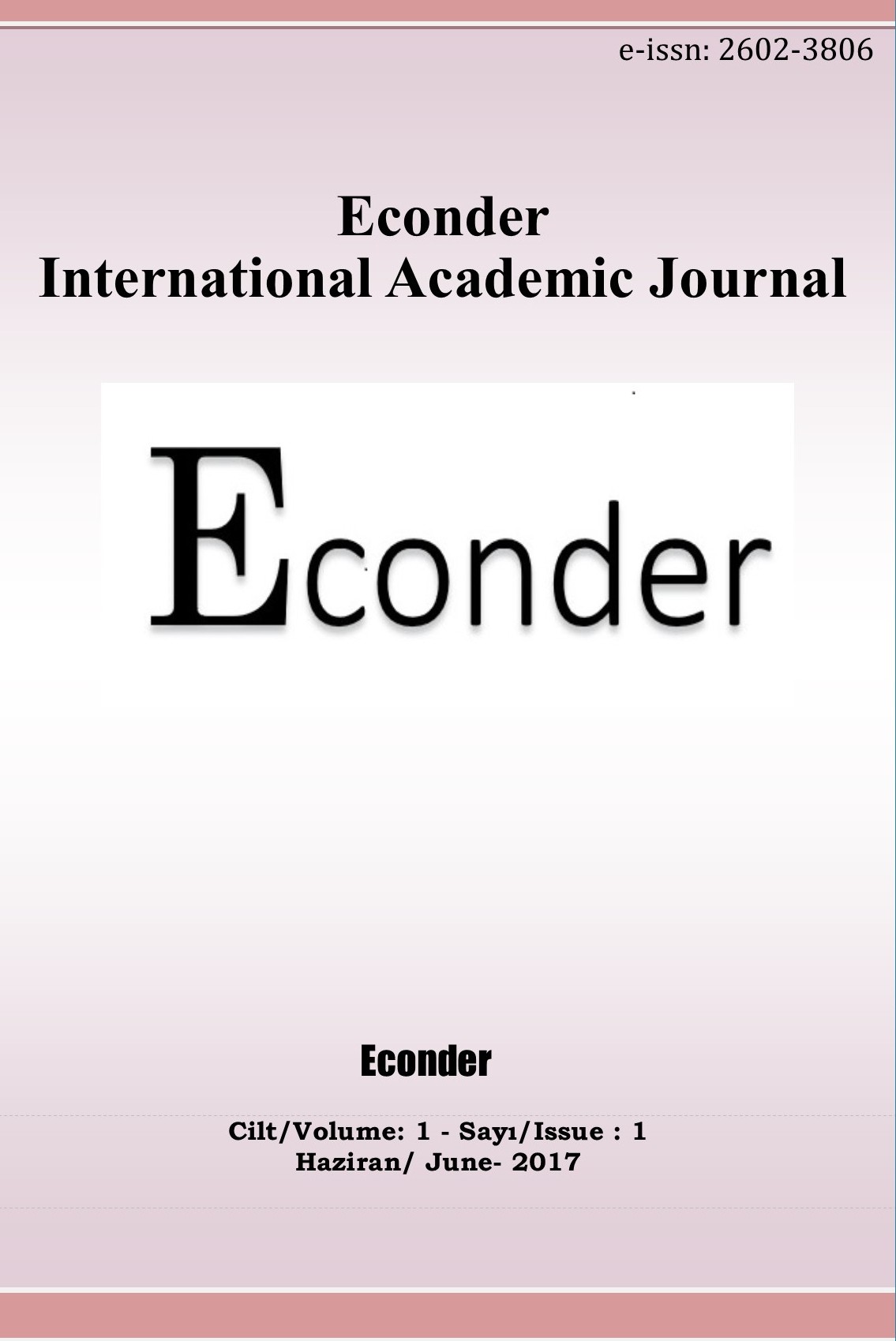Tersine Lojistikte Kritik Başarı Faktörlerinin DEMATEL Tekniği ile Değerlendirilmesi
Tersine Lojistik, Lojistik, DEMATEL, Çok Kriterli Karar Verme, Gıda Sektörü
Evaluation of Critical Success Factors in Logistics with DEMATEL Technique
Reverse Logistics, Logistics, DEMATEL, Multi Criteria Decision Making, Food Sector,
___
- Agrawal, S., Singh, R. K., & Murtaza, Q. (2015). A literature review and perspectives in reverse logistics. Resources, Conservation and Recycling, 97, 76-92.
- Alshamsi, A., & Diabat, A. (2017). A Genetic Algorithm for Reverse Logistics network design: A case study from the GCC. Journal of Cleaner Production, 151, 652-669.
- Bahiraei, N., Panjehfouladgaran, H., & Yusuff, R. M. (2015, March). Ranking of critical success factors in reverse logistics by TOPSIS. In Industrial Engineering and Operations Management (IEOM), 2015 International Conference on (pp. 1-5). IEEE.
- Chang, B., Chang, C. W., & Wu, C. H. (2011). Fuzzy DEMATEL method for developing supplier selection criteria. Expert systems with Applications, 38(3), 1850-1858.
- Chen, J.K. ve Chen, S., (2010). “Using a novel conjunctive MCDM approach based on DEMATEL, fuzzy ANP, and TOPSIS as an innovation support system for Taiwanese higher education”, Expert Systems with Applications 37. ss.1981-1990.
- Daugherty, P. J., Richey, R. G., Genchev, S. E., & Chen, H. (2005). Reverse logistics: superior performance through focused resource commitments to information technology. Transportation Research Part E: Logistics and Transportation Review, 41(2), 77-92.
- Daugherty, P. J., Autry, C. W., & Ellinger, A. E. (2001). Reverse logistics: the relationship between resource commitment and program performance. Journal of business logistics, 22(1), 107-123.
- De Brito, M. P., Flapper, S. D. P., & Dekker, R. (2002). Reverse Logistics: a review of case studies. Econometric Institute.
- Dekker, R., Fleischmann, M., Inderfurth, K., & Van Wassenhove, L. N. (2005). Reverse logistics: Quantitative models for closed-loop supply chains. Journal-Operatıonal Research Socıety, 56(6), 752-752.
- Dethloff, J. (2001). Vehicle routing and reverse logistics: the vehicle routing problem with simultaneous delivery and pick-up. OR-Spektrum, 23(1), 79-96.
- Eyüboğlu, G., & Bastı, M. (2017). Tersine lojistikte karşılaşılan sorunlar ve çözüm önerileri-Türk gıda sektörü örneği
- Fleischmann, M. (2001). Reverse logistics network structures and design.
- Fleischmann, M., Bloemhof-Ruwaard, J., Dekker, R., Van der Laan, E., van Nunen, J., & Van Wassenhove, L. (1997). Quantitative models for reverse logistics. European journal of operational research, 103, 1-17.
- Guide Jr, V. D. R., & Van Wassenhove, L. N. (2001). Managing product returns for remanufacturing. Production and operations management, 10(2), 142-155.
- Liou, J. H., Tzeng, G. H., ve Chang, H. C. (2007). “Airline Safety Measurement Using A Hybrid Model”, Journal of Air Transport Management, 13. ss.243-249.
- Murphy, P. (1986). A preliminary study of transportation and warehousing aspects of reverse distribution. Transportation Journal, 12-21.
- Paksoy, S., (2017). “Çok Kriterli Karar Vermede Güncel YaklaĢımlar”, Karahan Kitabevi, 1. Baskı, 117s.
- Prahinski, C., & Kocabasoglu, C. (2006). Empirical research opportunities in reverse supply chains. Omega, 34(6), 519-532.
- Sangwan, K. S. (2017). Key activities, decision variables and performance indicators of reverse logistics. Procedia CIRP, 61, 257-262.
- Tavana, M., Zareinejad, M., Di Caprio, D., & Kaviani, M. A. (2016). An integrated intuitionistic fuzzy AHP and SWOT method for outsourcing reverse logistics. Applied Soft Computing, 40, 544-557.
- Tibben-Lembke, R. S., ve Rogers, D. S. (1998). Going backwards: reverse logistics trends and practices. Reverse Logistics Executive Council.
- Tibben-Lembke, R. S., & Rogers, D. S. (2002). Differences between forward and reverse logistics in a retail environment. Supply Chain Management: An International Journal, 7(5), 271-282.
- Toffel, M. W. (2003). The growing strategic importance of end-of-life product management. California Management Review, 45(3), 102-129.
- Tzeng, G. H., Chiang, C. H., ve Li, C. W. (2007). Evaluating intertwined effects in e-learning programs: A novel hybrid MCDM model based on factor analysis and DEMATEL. Expert systems with Applications, 32(4), 1028-1044.
- Yayın Aralığı: Yılda 2 Sayı
- Başlangıç: 2017
- Yayıncı: Hayrettin KESGİNGÖZ
Türkiye’de Kadının İşgücüne Katılmadaki Yeri ve Uluslararası İstihdam Çabaları
Teknolojik Açığın Ülke-Spesifik Etkilerinin Belirlenmesi
Rukiye ÖZKAN, Oya ÖNALAN, Abdullah KARAKAYA
İnovasyon Stratejileri ve İşletme Performansı İlişkisi İhracat Yapan Firmalar Üzerine Bir Uygulama
Tükenmişlik Sendromu: Akademik Personel Üzerinde Bir İnceleme
Türkiye’de Cari İşlemler Açığın Nedenleri ve Cari İşlemler Açığı - Dış Ticaret Açığı İlişkisi
Stratejik Kalıcılık: Asya-Pasifik Ekseninde ABD’nin Menbiç Politikası
Fatma Zehra TAN, Şenol ÇEKİNMEZ, Mustafa Eren EROL
Dışsal Giriş Engelleri Firmaları Daha Az Rekabetçi mi Yapıyor? İnebolu’da Bir Alan Çalışması
Serkan DİLEK, Ali KONAK, Hayrettin KESGİNGÖZ, Havva ÖZDEMİR
Tersine Lojistikte Kritik Başarı Faktörlerinin DEMATEL Tekniği ile Değerlendirilmesi
